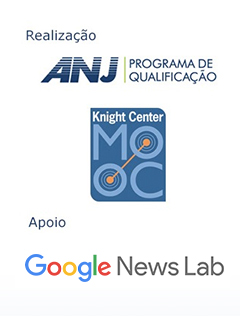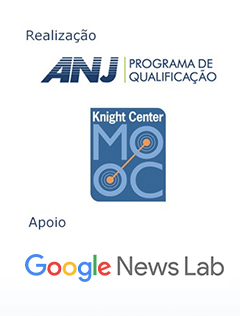
Producing effective video stories for digital platforms was the main theme of the massive open online course (MOOC) “Video journalism: Visual narratives for digital platforms.” It’s also what the ten students from the course who were selected to participate in an exclusive workshop with the team at YouTube Space in Rio de Janeiro tried to express in their projects.

More than 4,000 people participated in this course hosted by the National Association of Newspapers (ANJ for its acronym in Portuguese) and the Knight Center for Journalism in the Americas at the University of Texas at Austin with the support of Google News Lab. Alessandro Alvim and João Wainer led this four-week training program and presented the concepts and techniques of dynamic multimedia production for the Internet.
MOOC participants competed for 10 travel grants to participate in an exclusive video production seminar with the YouTube team, which will take place on Oct. 20 in the company’s newly opened space in Rio de Janeiro. Those who received the scholarships will also be able to personally meet instructors Wainer and Alvim, who taught the course between July 24 and Aug. 20.
Journalistic strength of the stories stands out among those projects selected. The videos deal with issues such as the routine of young residents of the Casa Santista Foundation (a teenagers’ recovery center), the perspective of a homeless person about public space, the judgment of an indigenous leader and the extreme poverty in areas of Recife. Creativity and the commitment to combine narrative elements more specific to documentaries were also present.
“The result of the competition was very interesting and served to show that the most important part of this course is to bring the concepts. From there, the creativity of the students is the limit,” Wainer commented. “From the results presented in the videos, it was clear that they understood and knew how to apply everything from the classroom soundly into their work.”
Alvim was also impressed with the quality of the work. “In addition to the concern with journalistic value, there was care with aesthetic and editing. They realized that video narrative for the web is first and foremost a good story. With good editing and applying the necessary resources, it is better constructed. The competitors applied the lessons and did a great job,” he said.
João Wainer and Alessandro Alvim are two veterans of multimedia production. Wainer was the founder of TV Folha and directed it for several years. He was the winner of the Esso Prize in the Telejournalism category for coverage of the June 2013 protests. For 17 years, Alvim edited graphic breaking news material and for three years he has been dedicated to innovative multimedia production at newspaper O Globo. He had works recognized by the Society for News Design (SND), SND-Digital, Inter American Press Association (IAPA), Prêmio Malofiej, Prêmio Esso and Prêmio Petrobras.
Following the lessons offered by the instructors, journalist Yuri Soares, from the Bahia newspaper Correio*, produced a video on the precarious conditions of workers at a cachaça factory that operated in the suburbs of Salvador, and was one of those selected in the final contest.
“With the course Videojournalism: Visual Narratives, I came to better understand my role as a reporter, as well as the potential of the audiovisual tool, in the journalistic context. Before the course, I ended up doing the reports without much planning, also a consequence of the lack of people in the team,” Soares said.
Aline Silva, from the Diário de Pernambuco, also applied the MOOC’s knowledge to build a video report about a Pernambuco capoeira icon, Mestre Meia-noite.
“The content of the course permeated the entire production process of my final project. I understood the ideal rhythm of a video for the internet, knowing how to attract the attention of the viewer, and knew the importance of each process, from conducting the interview with capturing sound and image with appropriate supports, to assembly and finalization,” said the journalist, who also had her work selected in the contest.
Creativity, talent, journalistic value and narrative construction were metrics used to judge the winning works. The theme or focus of the video was at the discretion of the participants. Below, see the list of students and click on their names to see the projects chosen:
All winning projects will be featured on YouTube Space and will receive direct feedback from the MOOC instructors. The video journalism workshop at Youtube Space will be offered only to the 10 award-winning students, and was organized to encourage students from the course to apply the learning gained into new journalistic products.
The MOOC program offered by the Knight Center of the University of Texas at Austin began in 2012 and is the only one in the world to offer open and massive online courses specializing in journalism. In five years, the initiative has already benefited more than 110,000 people from more than 170 countries.
“We are very grateful to Google News Lab for supporting us in massive Spanish and Portuguese courses that benefit thousands of journalists in Latin America,” said Professor Rosental Calmon Alves, founder and director of the Knight Center. “We also thank ANJ for this long partnership with us and with Google to bring knowledge to so many journalists, teachers and students of journalism programs from all regions of Brazil.”
The National Association of Newspapers brings together the main newspapers in Brazil. ANJ was created in 1979 to defend freedom of expression, thought and propaganda, the unrestricted operation of the press, observing the principles of responsibility, and fight for the defense of human rights, the values of representative democracy and free enterprise.
Google is a leading global technology company that is dedicated to improving the ways in which people connect with information. Google’s innovations in Internet search and advertising have made its site one of the leading Internet products and brands, one of the most recognized in the world.
The Knight Center for Journalism in the Americas was created in 2002 by Professor Rosental Calmon Alves, holder of the Knight Chair in Journalism and the School of Journalism at the University of Texas at Austin. The Center has received contributions from the John S. & James L. Knight Foundation and other donors.

Knight Center for Journalism in the Americas
300 West Dean Keeton
Room 3.212
Austin, TX, 78712
Phone: 512-471-1391
Email: journalismcourses@austin.utexas.edu